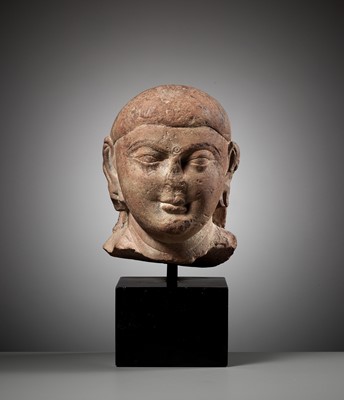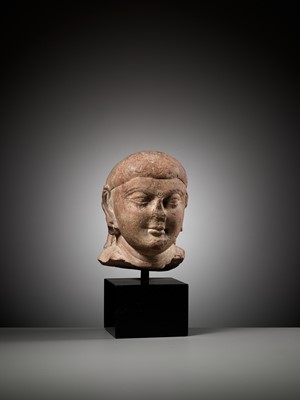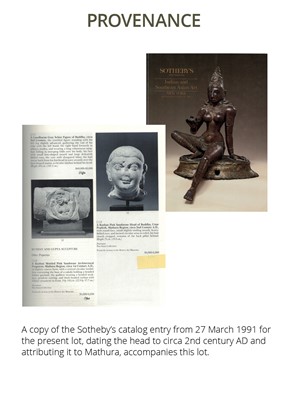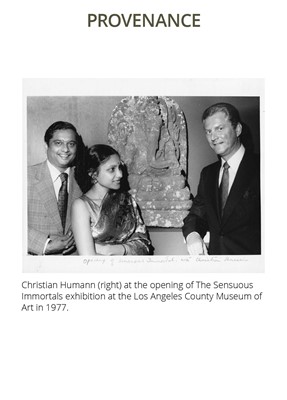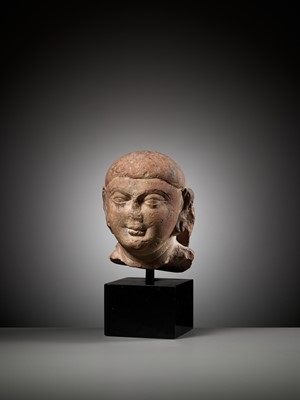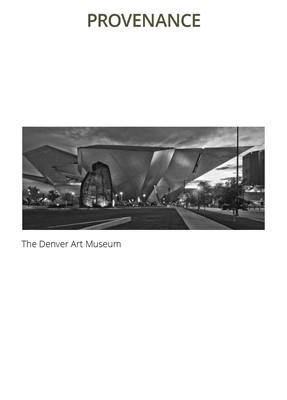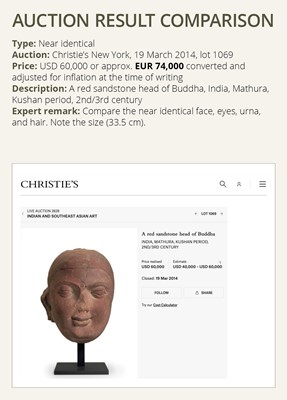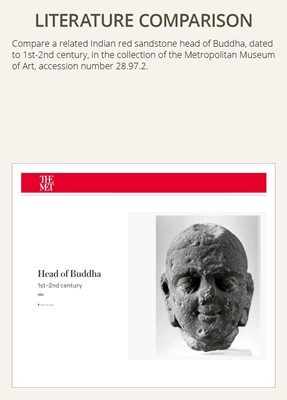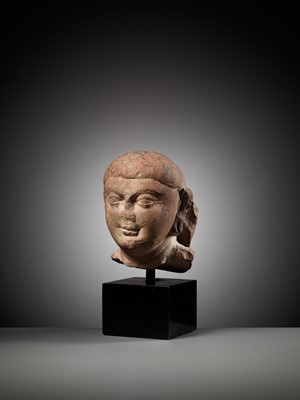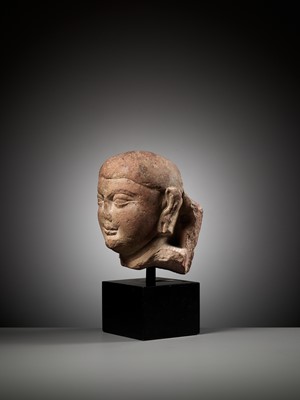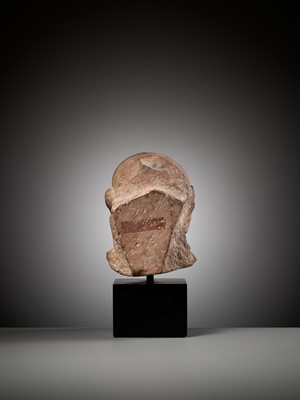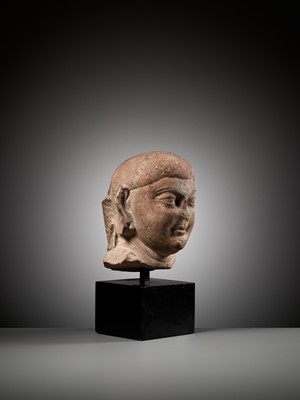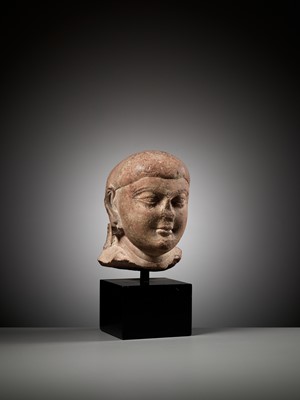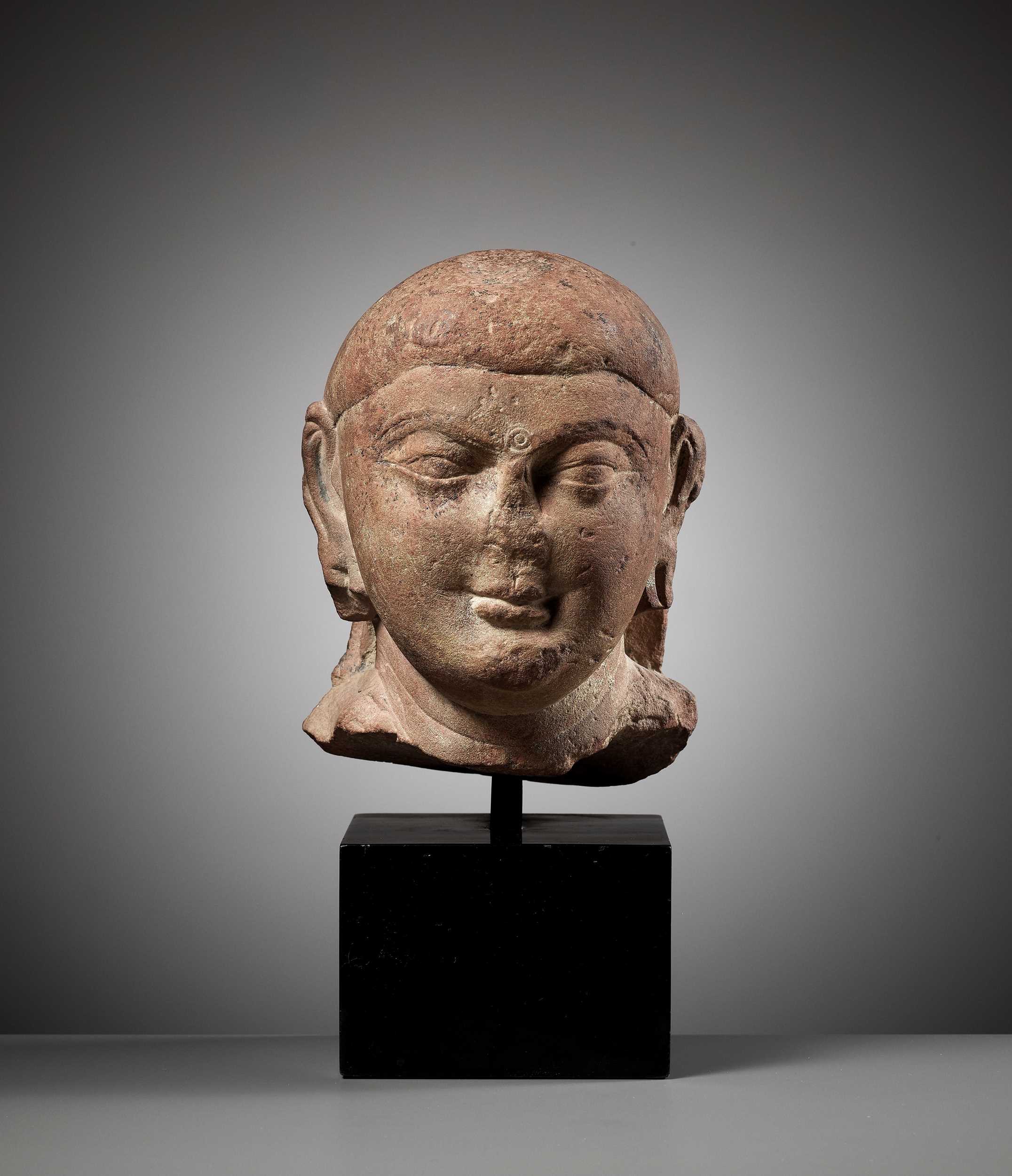30th Sep, 2022 10:00
DAY 2 - TWO-DAY AUCTION - Fine Chinese Art / 中國藝術集珍 / Buddhism & Hinduism
694
A PINK SANDSTONE HEAD OF BUDDHA, MATHURA, KUSHAN PERIOD
Sold for €10,400
including Buyer's Premium
India, Uttar Pradesh, 2nd-3rd century. The head finely carved with a round face, a gentle smile below heavy-lidded eyes, the brows centered by a circular urna, the face flanked by elongated ears and surmounted by closely cropped hair, remains of a back pillar.
Provenance: The Pan-Asian Collection of Christian Humann, Denver, Colorado, USA. Formerly on loan to the Denver Art Museum. Sotheby’s New York, 27 March 1991, lot 13, at an estimate of USD 4,000 or approx. EUR 8,500 (converted and adjusted for inflation at the time of writing). Stefaan Grusenmeyer, Belgium, acquired from the above. A noted Belgian private collection, acquired from the above in 1991 and thence by descent in the same family. A copy of the Sotheby’s catalog entry from 27 March 1991 for the present lot, dating the head to circa 2nd century AD and attributing it to Mathura, accompanies this lot. Christian Humann (1929-1981) was born in France and later moved to the United States, eventually becoming the Curator of Asian Art at the Denver Art Museum. Humann was an enthusiastic collector of Asian statues, and his Pan-Asian Collection included a vast number of sculptures spanning from Afghanistan to Southeast Asia over the last two millennia.
Condition: Good condition commensurate with age and overall as expected from a stone sculpture with an age of roughly two millennia. Extensive wear with signs of weathering and erosion, some nicks, structural cracks, and losses. Fine, naturally grown patina.
Weight: 5,390 g
Dimensions: Height 19.6 cm (excl. stand), 28.8 cm (incl. stand)
With a modern metal stand. (2)
Due to its location on the caravan trade routes through central India, Mathura was for centuries an important economic center. In the 2nd and 3rd centuries, it became a capital for the mighty Kushan Empire. During this time, both in Mathura and the region of Gandhara simultaneously, images of Buddha began to appear in anthropomorphic form for the first time. In contrast to Gandhara, where Graeco-Roman concerns for naturalism were stressed, the body types of the Mathura Buddhas convey an idealized Indian vitality.
Literature comparison:
Compare a related Indian red sandstone head of Buddha, dated to 1st-2nd century, in the collection of the Metropolitan Museum of Art, accession number 28.97.2.
Auction result comparison:
Type: Near identical
Auction: Christie’s New York, 19 March 2014, lot 1069
Price: USD 60,000 or approx. EUR 74,000 converted and adjusted for inflation at the time of writing
Description: A red sandstone head of Buddha, India, Mathura, Kushan period, 2nd/3rd century
Expert remark: Compare the near identical face, eyes, urna, and hair. Note the size (33.5 cm).
India, Uttar Pradesh, 2nd-3rd century. The head finely carved with a round face, a gentle smile below heavy-lidded eyes, the brows centered by a circular urna, the face flanked by elongated ears and surmounted by closely cropped hair, remains of a back pillar.
Provenance: The Pan-Asian Collection of Christian Humann, Denver, Colorado, USA. Formerly on loan to the Denver Art Museum. Sotheby’s New York, 27 March 1991, lot 13, at an estimate of USD 4,000 or approx. EUR 8,500 (converted and adjusted for inflation at the time of writing). Stefaan Grusenmeyer, Belgium, acquired from the above. A noted Belgian private collection, acquired from the above in 1991 and thence by descent in the same family. A copy of the Sotheby’s catalog entry from 27 March 1991 for the present lot, dating the head to circa 2nd century AD and attributing it to Mathura, accompanies this lot. Christian Humann (1929-1981) was born in France and later moved to the United States, eventually becoming the Curator of Asian Art at the Denver Art Museum. Humann was an enthusiastic collector of Asian statues, and his Pan-Asian Collection included a vast number of sculptures spanning from Afghanistan to Southeast Asia over the last two millennia.
Condition: Good condition commensurate with age and overall as expected from a stone sculpture with an age of roughly two millennia. Extensive wear with signs of weathering and erosion, some nicks, structural cracks, and losses. Fine, naturally grown patina.
Weight: 5,390 g
Dimensions: Height 19.6 cm (excl. stand), 28.8 cm (incl. stand)
With a modern metal stand. (2)
Due to its location on the caravan trade routes through central India, Mathura was for centuries an important economic center. In the 2nd and 3rd centuries, it became a capital for the mighty Kushan Empire. During this time, both in Mathura and the region of Gandhara simultaneously, images of Buddha began to appear in anthropomorphic form for the first time. In contrast to Gandhara, where Graeco-Roman concerns for naturalism were stressed, the body types of the Mathura Buddhas convey an idealized Indian vitality.
Literature comparison:
Compare a related Indian red sandstone head of Buddha, dated to 1st-2nd century, in the collection of the Metropolitan Museum of Art, accession number 28.97.2.
Auction result comparison:
Type: Near identical
Auction: Christie’s New York, 19 March 2014, lot 1069
Price: USD 60,000 or approx. EUR 74,000 converted and adjusted for inflation at the time of writing
Description: A red sandstone head of Buddha, India, Mathura, Kushan period, 2nd/3rd century
Expert remark: Compare the near identical face, eyes, urna, and hair. Note the size (33.5 cm).
Zacke Live Online Bidding
Our online bidding platform makes it easier than ever to bid in our auctions! When you bid through our website, you can take advantage of our premium buyer's terms without incurring any additional online bidding surcharges.
To bid live online, you'll need to create an online account. Once your account is created and your identity is verified, you can register to bid in an auction up to 12 hours before the auction begins.
Intended Spend and Bid Limits
When you register to bid in an online auction, you will need to share your intended maximum spending budget for the auction. We will then review your intended spend and set a bid limit for you. Once you have pre-registered for a live online auction, you can see your intended spend and bid limit by going to 'Account Settings' and clicking on 'Live Bidding Registrations'.
Your bid limit will be the maximum amount you can bid during the auction. Your bid limit is for the hammer price and is not affected by the buyer’s premium and VAT. For example, if you have a bid limit of €1,000 and place two winning bids for €300 and €200, then you will only be able to bid €500 for the rest of the auction. If you try to place a bid that is higher than €500, you will not be able to do so.
Online Absentee and Telephone Bids
You can now leave absentee and telephone bids on our website!
Absentee Bidding
Once you've created an account and your identity is verified, you can leave your absentee bid directly on the lot page. We will contact you when your bids have been confirmed.
Telephone Bidding
Once you've created an account and your identity is verified, you can leave telephone bids online. We will contact you when your bids have been confirmed.
Classic Absentee and Telephone Bidding Form
You can still submit absentee and telephone bids by email or fax if you prefer. Simply fill out the Absentee Bidding/Telephone bidding form and return it to us by email at office@zacke.at or by fax at +43 (1) 532 04 52 20. You can download the PDF from our Upcoming Auctions page.
How-To Guides
How to Create Your Personal Zacke Account
How to Register to Bid on Zacke Live
How to Leave Absentee Bids Online
How to Leave Telephone Bids Online
中文版本的操作指南
创建新账号
注册Zacke Live在线直播竞拍(免平台费)
缺席投标和电话投标
Third-Party Bidding
We partner with best-in-class third-party partners to make it easy for you to bid online in the channel of your choice. Please note that if you bid with one of our third-party online partners, then there will be a live bidding surcharge on top of your final purchase price. You can find all of our fees here. Here's a full list of our third-party partners:
- 51 Bid Live
- EpaiLive
- ArtFoxLive
- Invaluable
- LiveAuctioneers
- the-saleroom
- lot-tissimo
- Drouot
Please note that we place different auctions on different platforms. For example, in general, we only place Chinese art auctions on 51 Bid Live.
Bidding in Person
You must register to bid in person and will be assigned a paddle at the auction. Please contact us at office@zacke.at or +43 (1) 532 04 52 for the latest local health and safety guidelines.
